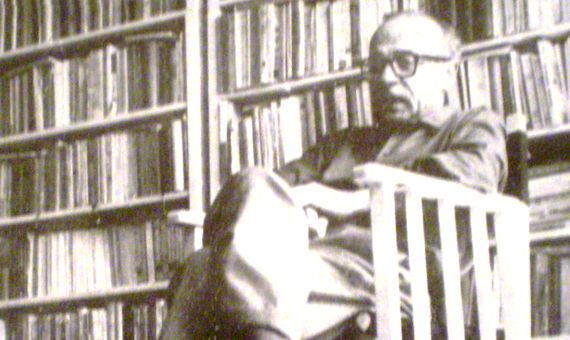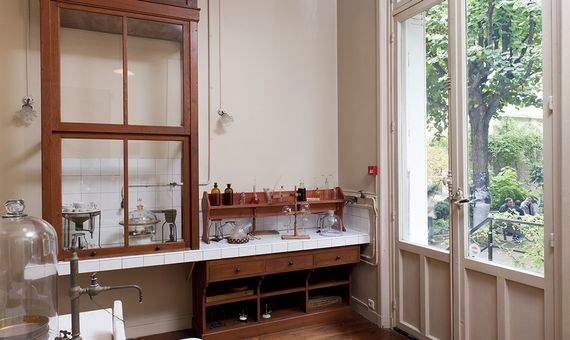Before becoming one of the most important writers of Hispanic-American literature, Ernesto Sábato was a renowned physicist who worked at top-level international centres such as the Curie Laboratory in Paris and the Massachusetts Institute of Technology (MIT). It was physics that took him to Paris, where, paradoxically, his lack of love for science began to take shape. Infected by the irreverence of the Parisian surrealists and “guided by a dark but persistent intuition,” he ended up abandoning his career in science to dedicate himself fully to writing.
Ernesto Sábato (24 June 1911 – 30 April 2011) was the tenth of eleven siblings, who lived in fear under the strict discipline of their father, for which the author himself confessed to feeling terror. However, at school he was a brilliant child, as Fernando Rodrigo Beltrán, expert in Sociology of Literature at the National Autonomous University of Mexico, recounts. But Sábato could not continue his high school studies in his birthplace, Rojas (an agricultural town of La Pampa), so at the age of thirteen he went to the city of La Plata to enrol in the National College of the University of La Plata.

In that same university, in 1929, he entered the Faculty of Physical-Mathematical Sciences. “You look for what you don’t have. I had no order and I looked for order because I didn’t have it. And the order par excellence is the order of mathematics,” Sábato explained in an interview with Televisión Española in 1977. But his militancy in the Communist Party—he became Secretary General of the Argentine Communist Youth Federation—led him to drop his studies and travel to Brussels and Paris.
In 1936, after abandoning communism, he returned clandestinely to Argentina and resumed his studies at university, where he obtained a Ph.D. in Physics and Mathematics two years later. “Nobody will suspect that that same year, when Professor Houssay, Nobel Prize in Physiology in 1947, awarded him a year-long scholarship to work and study at the Curie Institute in Paris, contact with surrealism will precipitate his disillusionment with science,” notes Beltrán.
Physicist in reference centres
The then-scientist settled in the French capital and began working with the Joliot-Curies, who made history investigating the nuclear fission. At the Curie Institute, the work of Ernesto Sábato focused on the study of atomic radiation, and it was there that he witnessed the splitting of the uranium atom, a step that would be critical for the manufacture of the atomic bomb. It was also there that Sábato, at that time spellbound by nuclear physics, simultaneously came into contact with the surrealist movement, which would eventually conquer him and which would mark his future as a man of letters.

Sábato described his stay in Paris in his book Antes del fin (Before the End) (1998): “During that time of antagonisms, I buried myself between electrometers and test tubes during the morning and spent the nights in bars, with the delirious surrealists.”
Just one year later, before the outbreak of the Second World War, the physicist moves to the Massachusetts Institute of Technology (USA), where he publishes a work on cosmic rays. In 1941 he returned to Argentina, already convinced that he wanted to abandon science and devote himself to literature. But before doing so, he undertook his last position as a scientist, working as an astrophysicist and teaching doctorate courses at the University of La Plata in order to fulfil his obligation to those who had awarded him the scholarship.
In 1943 he abandons science for good and he takes his family to live on a ranch in the province of Córdoba without electricity or heating. There, he writes Uno y el Universo (One and the Universe) (1945), his first book of essays.
He abandons everything for literature
For his professors, Enrique Gaviola, director of the Astronomical Observatory of Córdoba, and Guido Beck, a pupil of Einstein, literature was frivolous and they try to convince Sábato not to abandon his scientific career. “They only got me to promise to finish my theory on energy,” said the writer, as Vázquez Bigi recalls in the prologue of Sobre héroes y tombas (On Heroes and Tombs) (1961), one of his masterpieces.
What prompted the writer to choose literature? Even he doesn’t know. In Antes del fin he claims not to know why, at age thirty, when science assured him of a calm and respectable future, he abandoned everything “in exchange for a dark and lonely wasteland.”

What he does remember is how in the Curie laboratory he found himself empty and that, despite everything, he followed that scientific path for a few more years “because of a strong inertia” that his soul rejected. But his intuition did not fail him.
Sábato became one of the most important writers of Hispanic-American literature. He was the second Argentine to win the Miguel de Cervantes Prize, in 1984, after Jorge Luis Borges. Although science lost a physicist, literature gained a genius.
Comments on this publication